Culturally Relevant STEM (CReST): An Integrated Support Curriculum for High School Chemistry and World History
Abstract
1. Introduction
2. Literature Review and Theoretical Framework
2.1. Transdisciplinary and Convergence Education in STEM
2.2. Experiential Learning in STEM
2.3. Culturally Relevant Pedagogy in STEM
2.4. Intersecting the Four Axes through the Theoretical Framework of CReST
3. Materials and Methods
3.1. Research Design
3.2. Participants
3.3. Learning Intervention
3.3.1. Instructional Support Materials and Teacher Professional Development
3.3.2. High School Classroom Implementation
3.4. Data Collection and Analysis
3.4.1. Qualitative Data
3.4.2. Quantitative Data
3.5. Limitations
3.6. Validity and Reliability
4. Results
4.1. Qualitative Findings
4.1.1. Teacher Experiences
4.1.2. Student Experiences
4.2. Quantitative Findings
5. Discussion
5.1. Alignment of Themes with the Theoretical Framework
5.2. Teacher Professional Development and Implementation
5.3. Student Engagement with the Topic and Achievement
5.4. Assessment and Support Materials
6. Conclusions
Author Contributions
Funding
Institutional Review Board Statement
Informed Consent Statement
Data Availability Statement
Acknowledgments
Conflicts of Interest
Appendix A
- Which course are you currently enrolled in this year (Chemistry, AP Chemistry or World History I)?
- What is the purpose of making the under-drawing (sinopia) if it ends up getting covered by intonachino?
- What is the difference between paint and pigment?
- Which activity in the STEM cultural heritage conservation modules did you like? Why?
- While completing the STEM cultural heritage conservation activities (modules and hands-on lab activities), which parts of it helped you learn? Why?
- Did you think that the STEM cultural heritage conservation activity modules had an effective connection and flow with chemistry and world history content?
- How could the STEM cultural heritage conservation activity modules be altered to better support your learning goals?
Appendix B
- Which course(s) are you teaching this academic year?
- Which parts of the workshop did you find to be useful when implementing this learning approach in your classroom?
- Which components of the STEM cultural heritage conservation modules and hands-on learning activities did you find to be effective in your classroom?
- Which components of the STEM cultural heritage conservation modules and hands-on learning activities do you think assisted in student learning? Why?
- Did you think that the STEM cultural heritage conservation activity modules had an effective connection and flow between chemistry and world history content?
- How could the STEM cultural heritage conservation activity modules be altered to better support student learning goals?
- Would you like to facilitate other lessons with the integration of transdisciplinary STEM cultural heritage conservation?
References
- Bottia, M.C.; Stearns, E.; Mickelson, R.A.; Moller, S.; Parker, A.D. The Relationships among High School STEM Learning Experiences and Students’ Intent to Declare and Declaration of a STEM Major in College. Teach. Coll. Rec. Voice Scholarsh. Educ. 2015, 117, 1–46. [Google Scholar] [CrossRef]
- Council, N.R. A Framework for K-12 Science Education: Practices, Crosscutting Concepts, and Core Ideas; National Academies Press: Washington, DC, USA, 2012. [Google Scholar]
- Catsambis, S. Gender, race, ethnicity, and science education in the middle grades. J. Res. Sci. Teach. 1995, 32, 243–257. [Google Scholar] [CrossRef]
- DeWitt, J.; Osborne, J.; Archer, L.; Dillon, J.; Willis, B.; Wong, B. Young Children’s Aspirations in Science: The unequivocal, the uncertain and the unthinkable. Int. J. Sci. Educ. 2013, 35, 1037–1063. [Google Scholar] [CrossRef]
- Jacobs, J.E.; Davis-Kean, P.; Bleeker, M.; Eccles, J.S.; Malanchuk, O. Gender Differences in Mathematics: An Integrative Psychological Approach; Gallagher, A., Kaufman, J., Eds.; Cambridge University Press: Cambridge, UK, 2005; pp. 246–263. [Google Scholar]
- Griffiths, P.; Cahill, M. The Opportunity Equation: Transforming Mathematics and Science Education for Citizenship and the Global Economy; Carnegie Cooperation of New York and Institute for Advanced Study: New York, NY, USA, 2009. [Google Scholar]
- Burke, A.; Okrent, A.; Hale, K.; Gough, N. The State of U.S. Science & Engineering 2022. National Science Board Science & Engineering Indicators. NSB-2022-1. National Science Foundation. Available online: https://ncses.nsf.gov/pubs/nsb20221/executive-summary (accessed on 31 December 2021).
- Interagency Working Group on Convergence Federal Coordination in STEM Education National Science and Technology Council. Convergence Education: A Guide to Transdisciplinary STEM Learning and Teaching. A Report by the Interagency Working Group on Convergence Federal Coordination in STEM Education of the National Science and Technology Council. 2022. Available online: https://www.whitehouse.gov/wp-content/uploads/2022/11/Convergence_Public-Report_Final.pdf (accessed on 1 March 2023).
- Widya; Rifandi, R.; Laila Rahmi, Y. STEM education to fulfil the 21st century demand: A literature review. J. Phys. Conf. Ser. 2019, 1317, 012208. [Google Scholar] [CrossRef]
- Docktor, J.L.; Mestre, J.P. Synthesis of discipline-based education research in physics. Phys. Rev. Spec. Top. Phys. Educ. Res. 2014, 10, 020119. [Google Scholar] [CrossRef]
- NGSS Lead States. Next Generation Science Standards: For States, by States; National Academies Press: Washington, DC, USA, 2013. [Google Scholar]
- Committee on STEM Education of the National Science & Technology Council. Chartering a Course for Success: America’s Strategy for STEM Education. 2018. Available online: https://trumpwhitehouse.archives.gov/wp-content/uploads/2018/12/STEM-Education-Strategic-Plan-2018.pdf (accessed on 15 December 2021).
- Helmane, I.; Briška, I. What is developing integrated or interdisciplinary or multidisciplinary or transdisciplinary education in school? J. Pedagog. Psychol. Signum Temporis 2017, 9, 7–15. [Google Scholar] [CrossRef]
- Vasquez, J.A.; Sneider, C.; Comer, M. STEM Lesson Essentials, Grades 3–8: Integrating Science, Technology, Engineering, and Mathematics; Heinemann: Portsmouth, NH, USA, 2013. [Google Scholar]
- Conradty, C.; Sotiriou, S.A.; Bogner, F.X. How Creativity in STEAM Modules Intervenes with Self-Efficacy and Motivation. Educ. Sci. 2020, 10, 70. [Google Scholar] [CrossRef]
- Century, J.; Ferris, K.A.; Zuo, H. Finding time for computer science in the elementary school day: A quasi-experimental study of a transdisciplinary problem-based learning approach. Int. J. STEM Educ. 2020, 7, 20. [Google Scholar] [CrossRef]
- Gibson, H. From Ideas to Action: Transforming Learning to Inspire Action on Critical Global Issues; Smithsonian Institution Scholarly Press: Washington, DC, USA, 2021. [Google Scholar] [CrossRef]
- O’Mahony, T.K.; Vye, N.J.; Bransford, J.D.; Sanders, E.A.; Stevens, R.; Stephens, R.D.; Richey, M.C.; Lin, K.Y.; Soleiman, M.K. A Comparison of Lecture-Based and Challenge-Based Learning in a Workplace Setting: Course Designs, Patterns of Interactivity, and Learning Outcomes. J. Learn. Sci. 2012, 21, 182–206. [Google Scholar] [CrossRef]
- Walker, A.; Leary, H. A Problem Based Learning Meta Analysis: Differences Across Problem Types, Implementation Types, Disciplines, and Assessment Levels. Interdiscip. J. Probl. Based Learn. 2009, 3, 3. [Google Scholar] [CrossRef]
- Gao, X.; Li, P.; Shen, J.; Sun, H. Reviewing assessment of student learning in interdisciplinary STEM education. Int. J. STEM Educ. 2020, 7, 24. [Google Scholar] [CrossRef]
- Kolb, D.A. Experiential Learning: Experiences as the Source of Learning and Development; Prentice Hall. Lestari: Hoboken, NJ, USA, 1984. [Google Scholar]
- Lestari, I.F. Experiential learning using STEM approach in improving students’ problem-solving ability. J. Phys. Conf. Ser. 2021, 1806, 012005. [Google Scholar] [CrossRef]
- Tien Long, N.; Thi Hoang Yen, N.; Van Hanh, N. The Role of Experiential Learning and Engineering Design Process in K-12 Stem Education. Int. J. Educ. Pract. 2020, 8, 720–732. [Google Scholar] [CrossRef]
- Wong, N.H.L.; Tong, A.S.K.; Posner, M.T. Modular and extensible lesson on optical fibre communication for youths. Phys. Educ. 2019, 54, 055004. [Google Scholar] [CrossRef]
- Crodua, J., Jr. Relationship of modular learning modality to the students’ mathematics performance in the new normal environment. J. Math. Sci. Teach. 2023, 3, em026. [Google Scholar] [CrossRef]
- Johnson, A.; Elliott, S. Culturally relevant pedagogy: A model to guide cultural transformation in STEM departments. J. Microbiol. Biol. Educ. 2020, 21. [Google Scholar] [CrossRef]
- Ladson-Billings, G. Toward a theory of culturally relevant pedagogy. Am. Educ. Res. J. 1995, 32, 465–491. [Google Scholar] [CrossRef]
- Young, J.; Young, J.; Cason, M.; Ortiz, N.; Foster, M.; Hamilton, C. Concept raps versus concept maps: A culturally responsive approach to stem vocabulary development. Educ. Sci. 2018, 8, 108. [Google Scholar] [CrossRef]
- Kim, D.; Kim, S.L.; Barnett, M. “That makes sense now!”: Bicultural middle school students’ learning in a culturally relevant science classroom. Int. J. Multicult. Educ. 2021, 23, 145–172. [Google Scholar] [CrossRef]
- Emdin, C.; Adjapong, E.; Levy, I. Hip-hop based interventions as pedagogy/therapy in STEM. J. Multicult. Educ. 2016, 10, 307–321. [Google Scholar] [CrossRef]
- Brown, B.A.; Boda, P.; Lemmi, C.; Monroe, X. Moving culturally relevant pedagogy from theory to practice: Exploring teachers’ application of culturally relevant education in science and Mathematics. Urban Educ. 2018, 54, 775–803. [Google Scholar] [CrossRef]
- Emdin, C. Affiliation and alienation: Hip-hop, Rap, and Urban Science Education. J. Curric. Stud. 2010, 42, 1–25. [Google Scholar] [CrossRef]
- Leung, A. Boundary Crossing pedagogy in STEM Education. Int. J. STEM Educ. 2020, 7, 15. [Google Scholar] [CrossRef]
- Herr, D.J.C.; Akbar, B.; Brummet, J.; Flores, S.; Gordon, A.; Gray, B.; Murday, J. Convergence education—An international perspective. J. Nanoparticle Res. 2019, 21, 229. [Google Scholar] [CrossRef]
- Onwuegbuzie, A.; Leech, N. Linking research questions to mixed methods data analysis procedures 1. Qual. Report 2015, 11, 474–498. [Google Scholar] [CrossRef]
- Campbell, D.T.; Stanley, J.C. Experimental and Quasi-Experimental Designs for Research; Houghton Mifflin Company Boston: Wadsworth, OH, USA, 2011; pp. 34–61. [Google Scholar]
- Creswell, J.; Clark, V. Designing and Conducting Mixed Methods Research; SAGE: Riverside County, CA, USA, 2018. [Google Scholar]
- Bonsanti, G. Theory, Methodology, and Practical Applications–Painting Conservation in Italy in the Twentieth Century. In Early Italian Painting: Approaches to Conservation. Proceedings of a Symposium at the Yale University Art Gallery; Garland, P.S., Ed.; Yale University Press: New Haven, CT, USA; London, UK, 2003; Volume 1, pp. 82–97. [Google Scholar]
- Giorgio, V.; Hinds, A.B. The Lives of the Painters, Sculptors & Architects; J. M. Dent & Sons, Ltd.: London, UK; Toronto, ON, Cannada, 1927; pp. 1511–1574. [Google Scholar]
- Ciatti, M. Approaches to Retouching and Restoration: Pictorial Restoration in Italy. In Early Italian Painting: Approaches to Conservation. Proceedings of a Symposium at the Yale University Art Gallery; Garland, P.S., Ed.; Yale University Press: New Haven, CT, USA; London, UK, 2003; Volume 1, pp. 191–207. [Google Scholar]
- Santa Croce, Florence, Italy. Santa Croce. 2009. Available online: https://www.santacroceopera.it/en/ (accessed on 10 April 2022).
- Conway, P.; O’Hara, M. Flood in Florence, 1966: A Fifty-Year Retrospective; Conway, P., Ed.; Michigan Publishing, University of Michigan Library: Ann Arbor, MI, USA, 2018. [Google Scholar] [CrossRef]
- Baglioni, P.; Chelazzi, D. Nanoscience for the Conservation of Works of Art; Royal Society of Chemistry: London, UK, 2015. [Google Scholar]
- Baglioni, P.; Chelazzi, D.; Giorgi, R. Nanotechnologies in the Conservation of Cultural Heritage; Springer: Berlin/Heidelberg, Germany, 2014. [Google Scholar]
- CSGI—Center for Colloid and Surface Science. 2020. Available online: https://www.csgi.unifi.it/ (accessed on 8 April 2022).
- Dei, L. Biography—Fondazione Prof. Enzo Ferroni. 2012. Available online: https://www.fondazioneferroni.it/en/contents/biography/53 (accessed on 8 April 2022).
- Stake, R.E. The Art of Case Study Research; SAGE Publications: Riverside County, CA, USA, 1995. [Google Scholar]
- Flick, U.; Flick, U. The Sage Handbook of Qualitative Data Analysis; SAGE: Riverside County, CA, USA, 2017. [Google Scholar]
- Muijs, D. Doing Quantitative Research in Education with SPSS; SAGE: Riverside County, CA, USA, 2011. [Google Scholar]
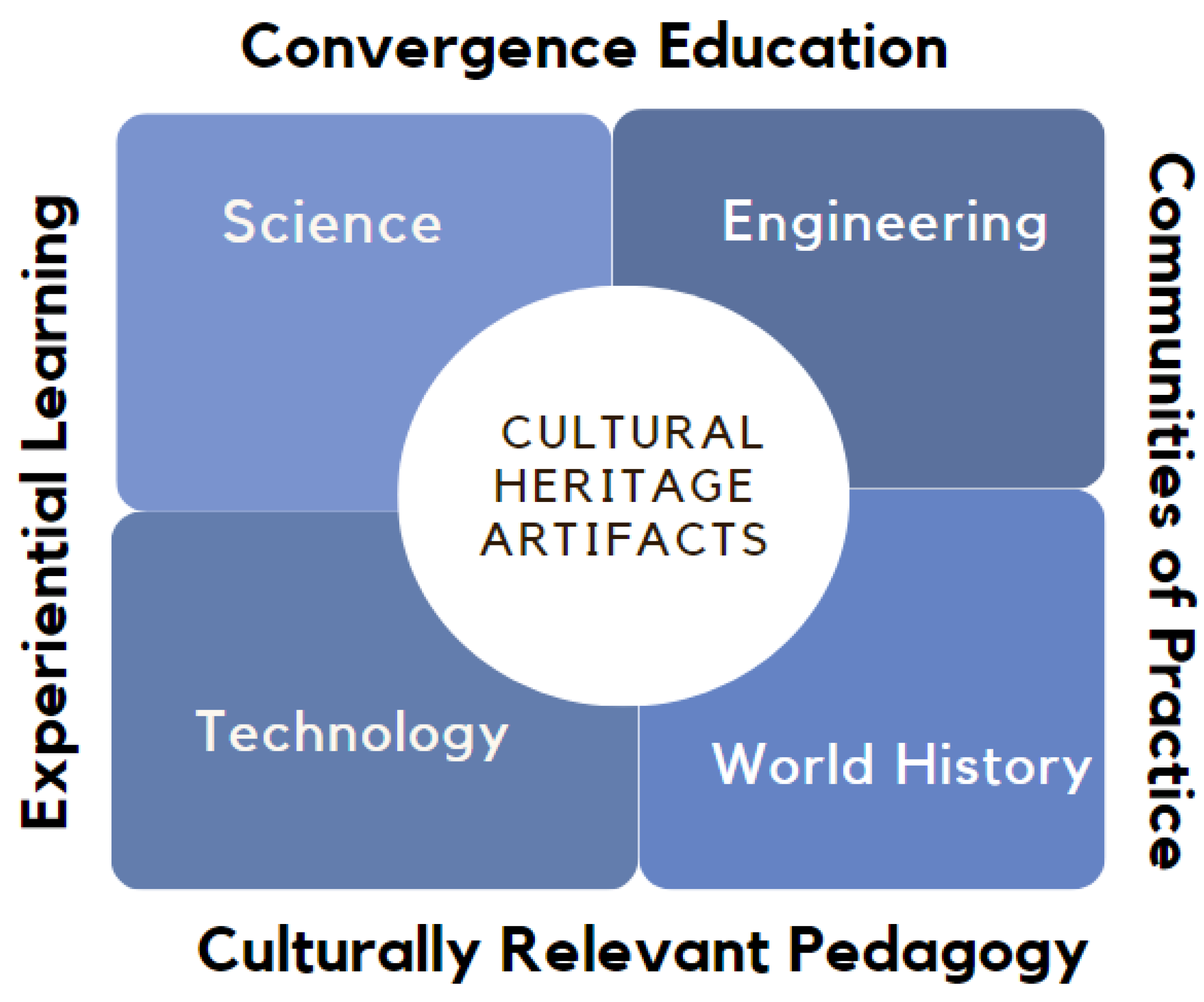
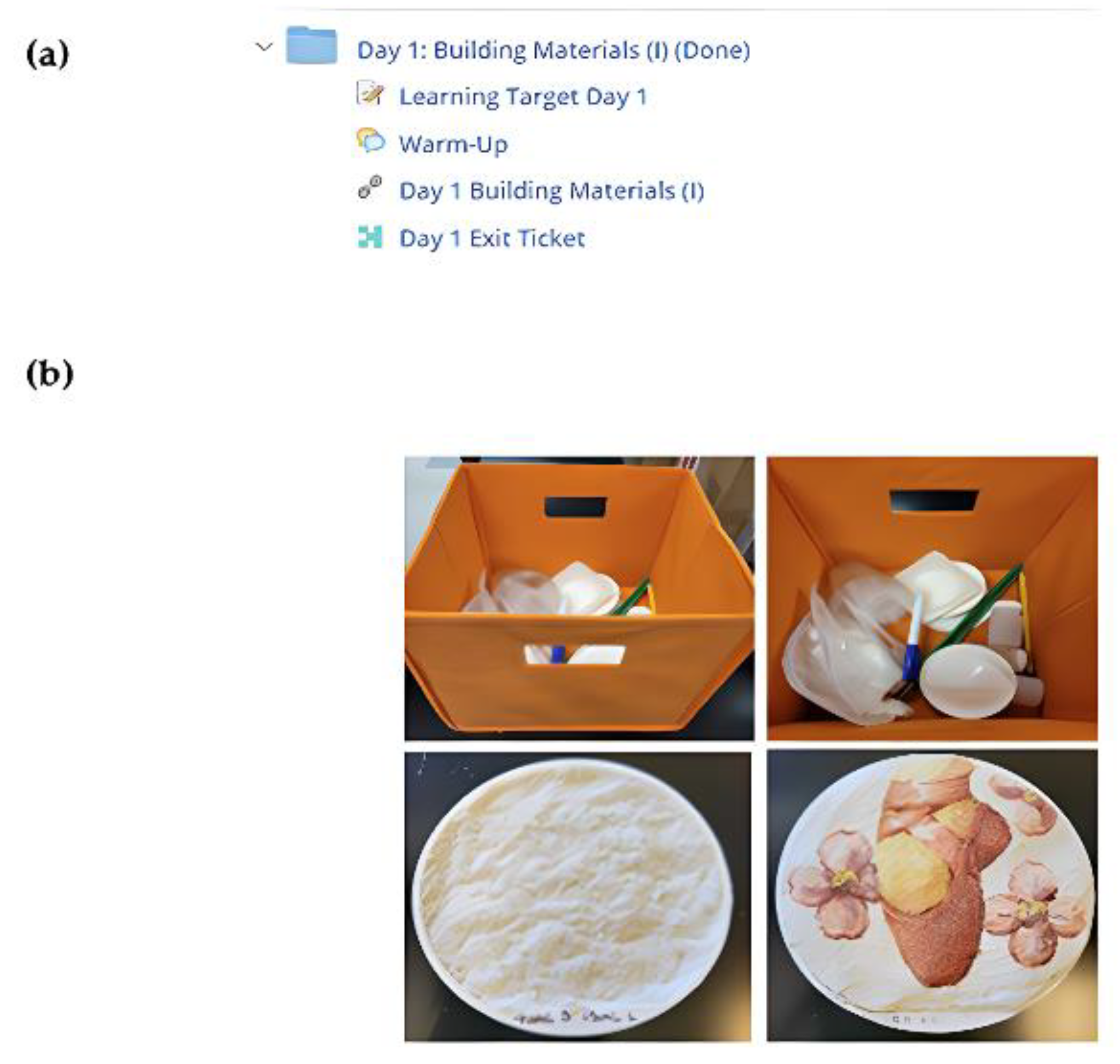
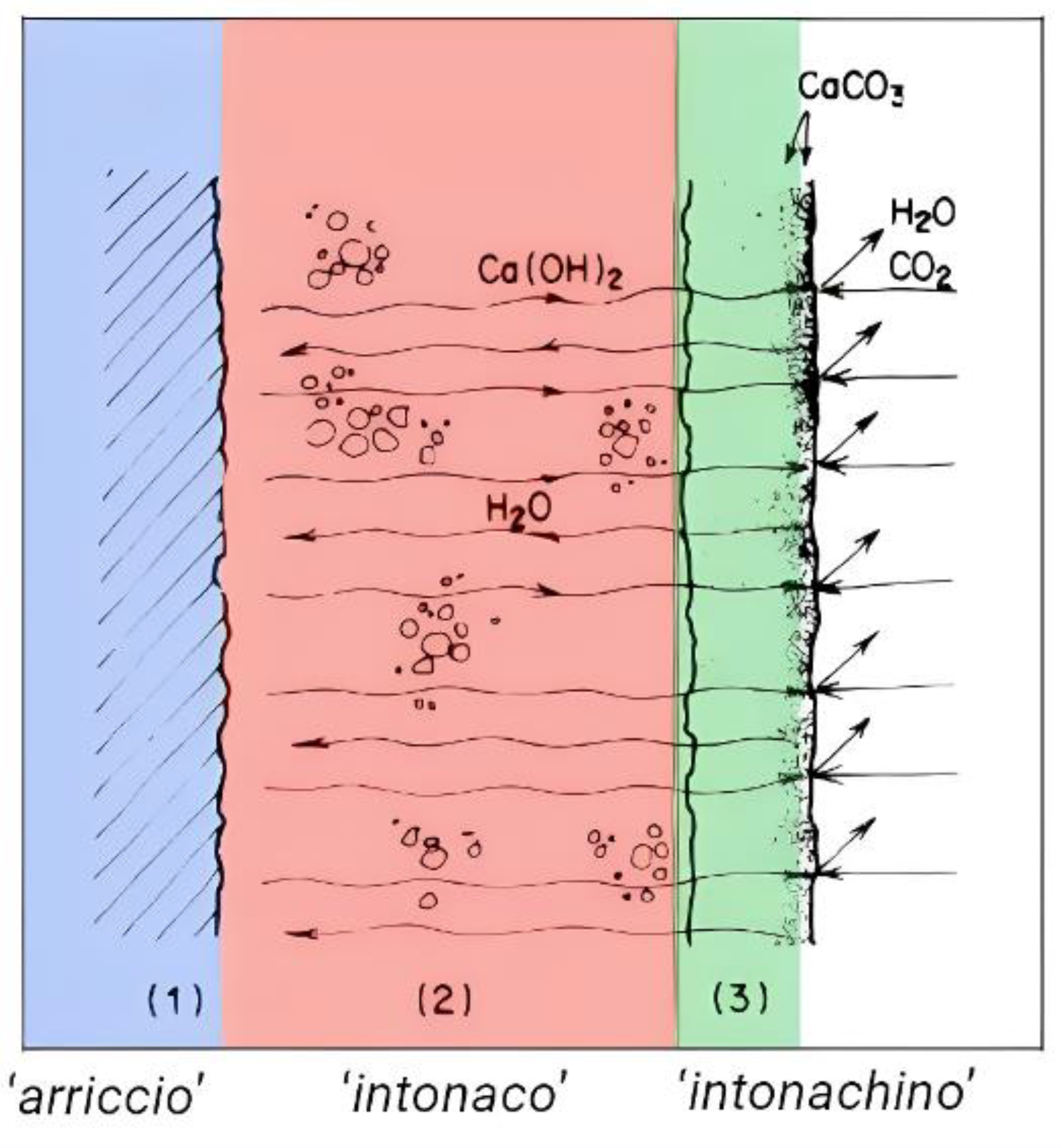
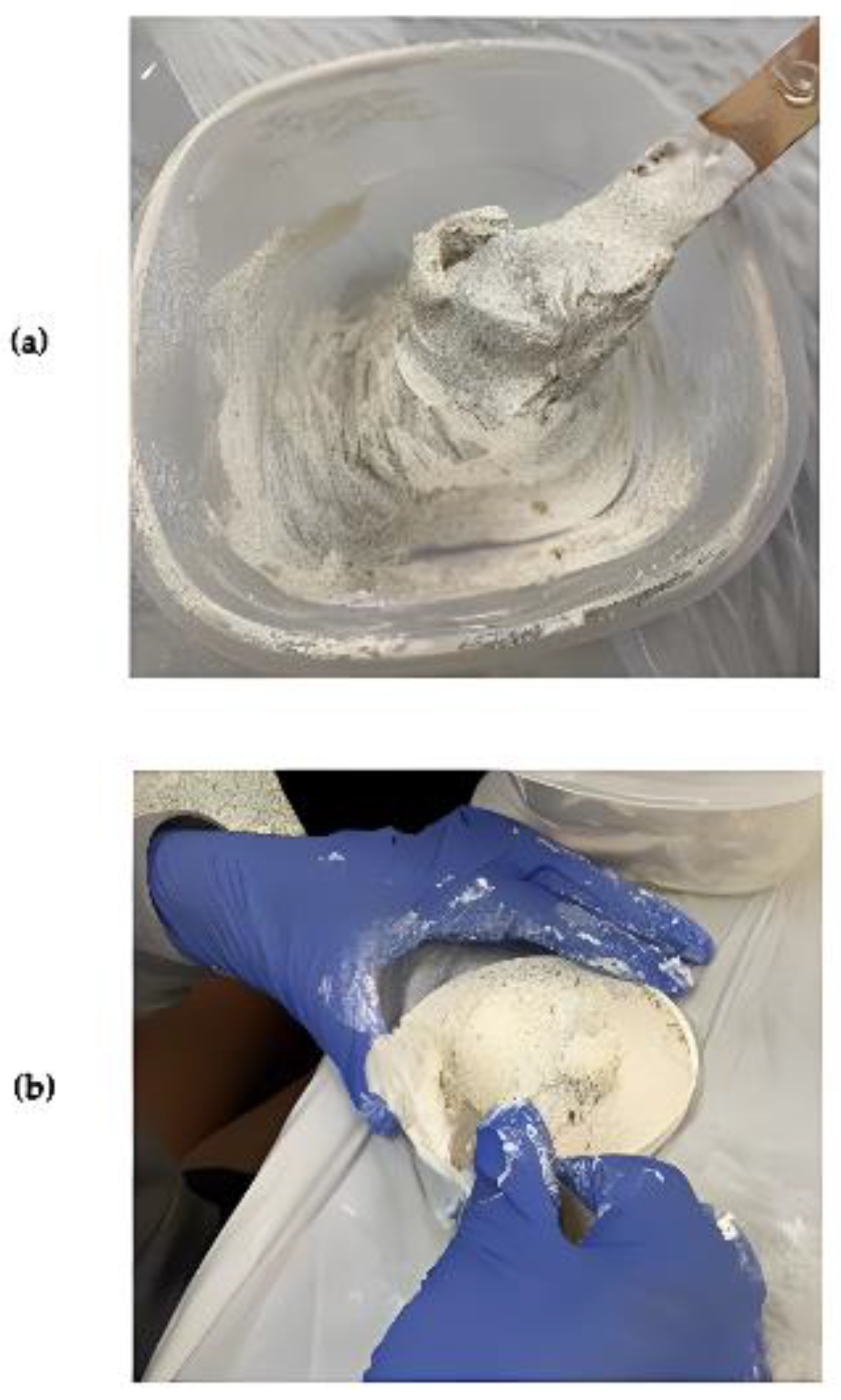
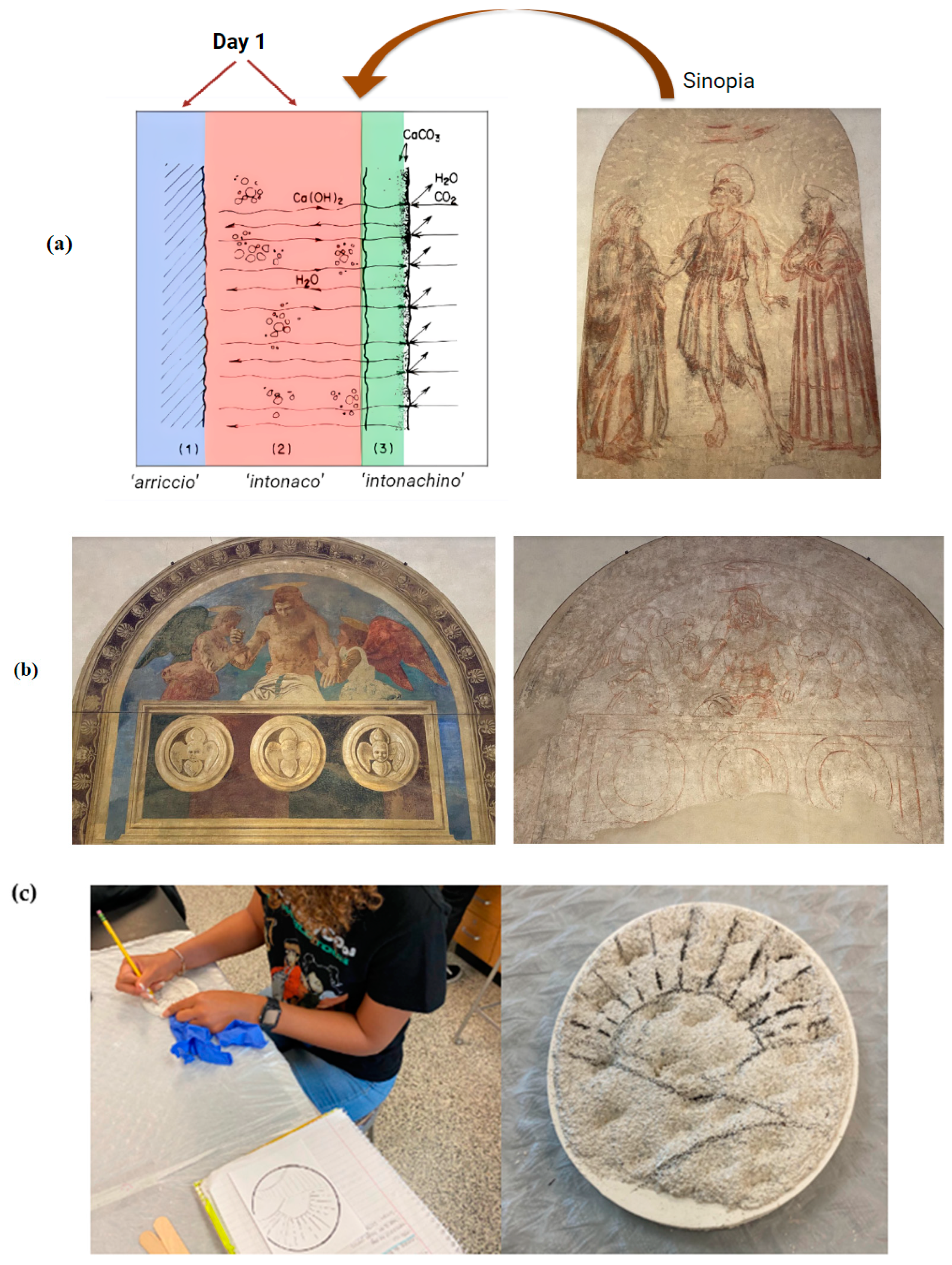
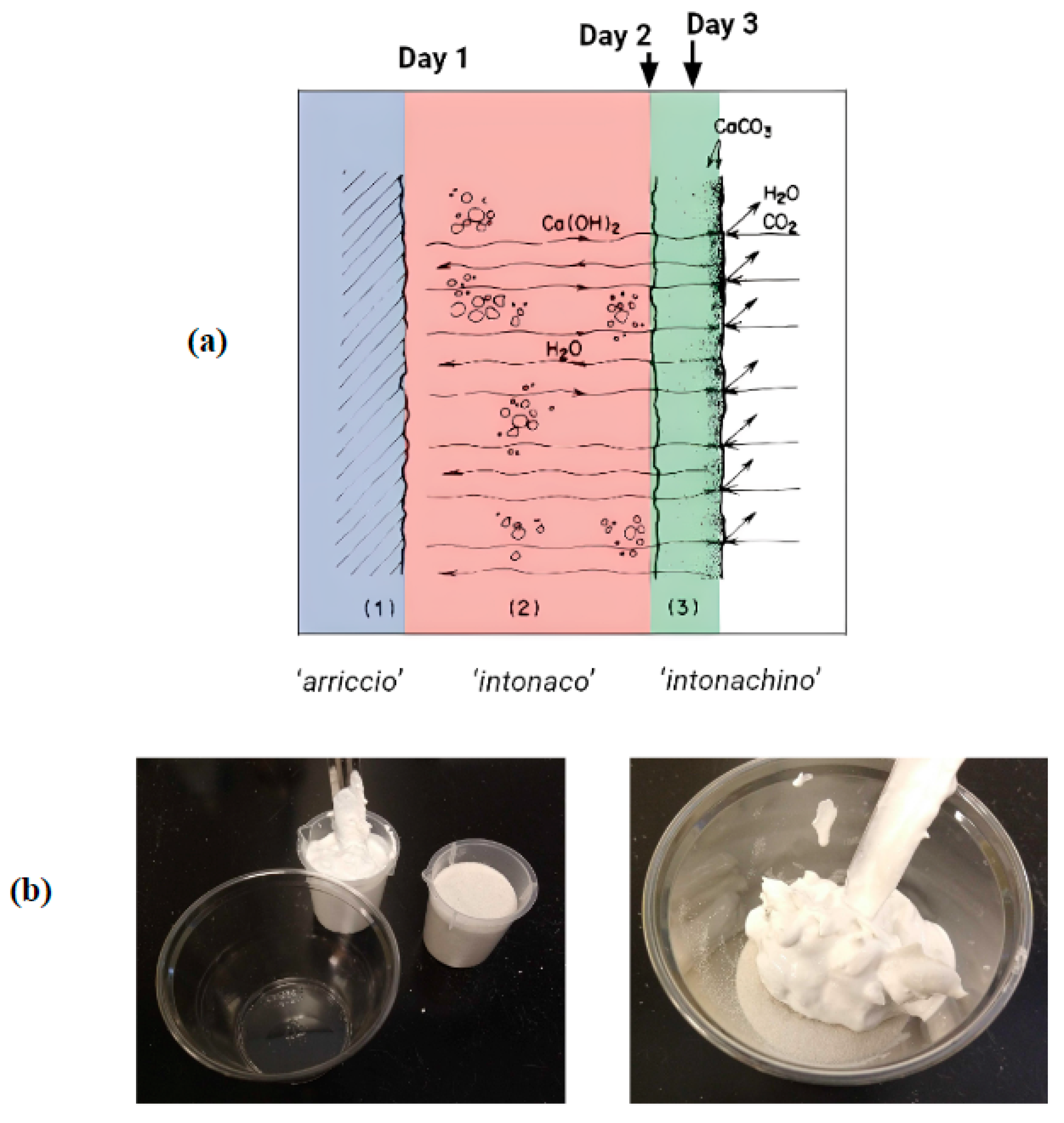

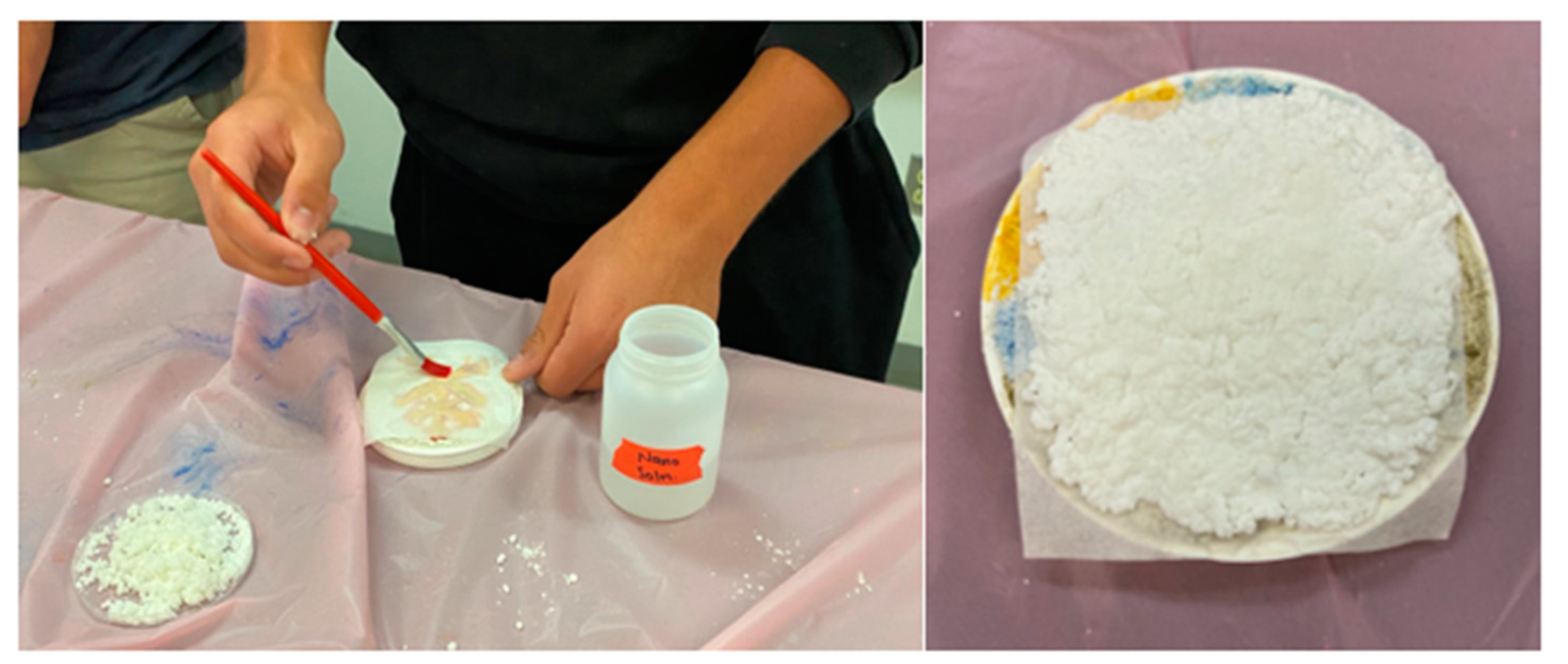
| Chemistry Learning Objective | World History Learning Objective |
|---|---|
| CH.7 The student will investigate and understand that thermodynamics explains the relationship between matter and energy. | WHI.15 The student will apply social science skills to understand the developments leading to the Renaissance in Europe in terms of its impact on Western civilization by |
|
|
|
|
|
|
| Day 1 | Day 2 | Day 3 | Day 4 | Day 5 | Day 6 | |
|---|---|---|---|---|---|---|
| STEM Context: | Chemistry: Energy | Design | Chemistry: Reactions | Chemistry: Solutions and Dispersions | Environmental Chemistry | Nano chemistry |
| Experiential Activity: | Building Materials (I) | Sinopia | Building Materials (II) | Fresco Painting | Fresco Degradation | Fresco Conservation |
| Historical Context: Great Thinkers | Brunelleschi | Leonardo | Vasari | Michaelangelo | Ferroni | Baglioni |
| n = 276 | PRE-Test Mean | POST-Test Mean | Mean Difference | p-Value |
|---|---|---|---|---|
| Chemistry Questions (10) | 69.3 | 73.2 | 4.0 | <0.001 |
| World History I and II Questions (6) | 68.4 | 81.8 | 13.4 | <0.001 |
| n = 19 | PRE-TestMean | POST-TestMean | Mean Difference | p-Value |
|---|---|---|---|---|
| Chemistry Questions (10) | 32.1 | 33.7 | 1.6 | >0.05 |
| World History I and II Questions (6) | 55.3 | 65.8 | 10.5 | <0.001 |
| Factors of Interactive STEM Pedagogy | CReST Curriculum in High School Chemistry and World History |
|---|---|
| Convergence Education |
|
| Experiential Learning |
|
| Communities of Practice |
|
| Culturally Relevant Pedagogy |
|
Disclaimer/Publisher’s Note: The statements, opinions and data contained in all publications are solely those of the individual author(s) and contributor(s) and not of MDPI and/or the editor(s). MDPI and/or the editor(s) disclaim responsibility for any injury to people or property resulting from any ideas, methods, instructions or products referred to in the content. |
© 2024 by the authors. Licensee MDPI, Basel, Switzerland. This article is an open access article distributed under the terms and conditions of the Creative Commons Attribution (CC BY) license (https://creativecommons.org/licenses/by/4.0/).
Share and Cite
Ferri, J.K.; White, R.S. Culturally Relevant STEM (CReST): An Integrated Support Curriculum for High School Chemistry and World History. Educ. Sci. 2024, 14, 182. https://doi.org/10.3390/educsci14020182
Ferri JK, White RS. Culturally Relevant STEM (CReST): An Integrated Support Curriculum for High School Chemistry and World History. Education Sciences. 2024; 14(2):182. https://doi.org/10.3390/educsci14020182
Chicago/Turabian StyleFerri, James K., and Rachel Sparks White. 2024. "Culturally Relevant STEM (CReST): An Integrated Support Curriculum for High School Chemistry and World History" Education Sciences 14, no. 2: 182. https://doi.org/10.3390/educsci14020182
APA StyleFerri, J. K., & White, R. S. (2024). Culturally Relevant STEM (CReST): An Integrated Support Curriculum for High School Chemistry and World History. Education Sciences, 14(2), 182. https://doi.org/10.3390/educsci14020182








